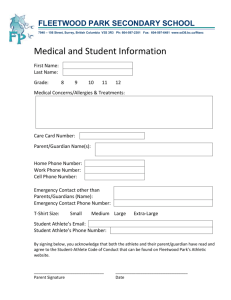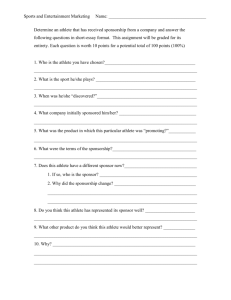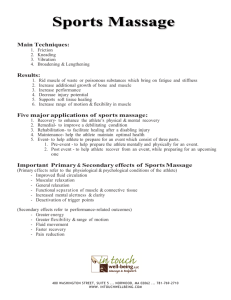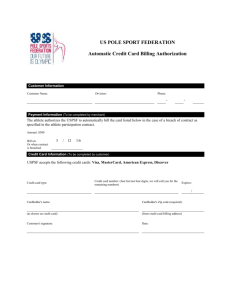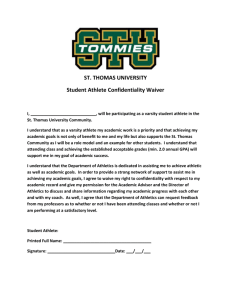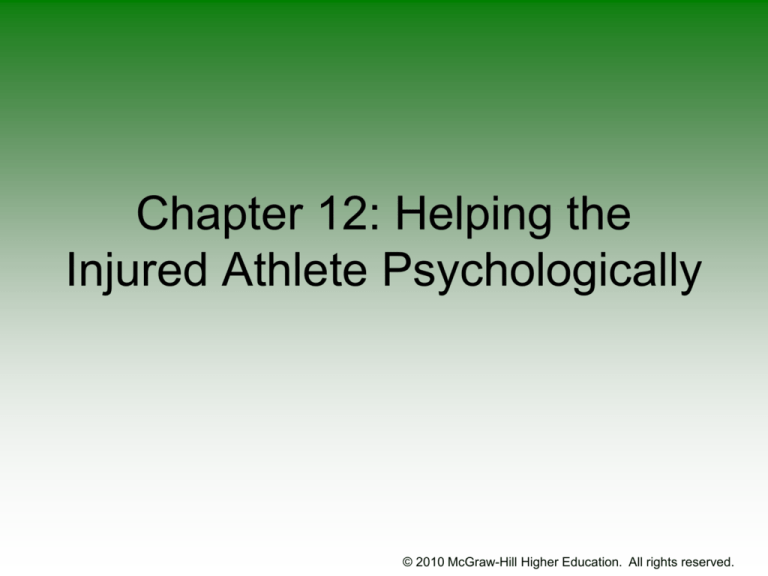
Chapter 12: Helping the
Injured Athlete Psychologically
© 2010 McGraw-Hill Higher Education. All rights reserved.
• An athlete’s mind is also affected when
the body is injured
• Negative psychological response to injury
often results in longer and more difficult
period of rehabilitation
• Appropriate psychological care provided
by the sports medicine team may
facilitate the athlete’s return to
competition
• Must work together to get the mind and
body ready to return to competition
© 2010 McGraw-Hill Higher Education. All rights reserved.
• Coaches and fitness professionals
working with injured athletes must have
an understanding of how athletes react
to injury and the rehabilitation process
• The manner in which coaches and
professionals support the injured athlete
can have a dramatic impact on the
rehabilitation process
© 2010 McGraw-Hill Higher Education. All rights reserved.
Athletes Psychological
Response to Injury
• Athletes deal with injury differently
– Viewed as disastrous, an opportunity to
show courage, use as an excuse for poor
performance, or exhibit courage
• Severity of injury and length of rehab
– Short term (<4 weeks)
– Long term (>4 weeks)
– Chronic (recurring)
– Terminating (career ending)
© 2010 McGraw-Hill Higher Education. All rights reserved.
• No matter the length of time, three
reactive phases to the injury process
occur
– Reaction to injury
– Reaction to rehabilitation
– Reaction to return to play or termination of
career
• Other matters that must be considered are
past history, coping skills, social support
and personal traits
• Injury may impact a number of factors
socially and personally
– Be aware of possible self-esteem issues
© 2010 McGraw-Hill Higher Education. All rights reserved.
Predictors of Injury
• Some psychological traits may predispose
athlete to injury
– No one personality type
– Risk takers, reserved, detached or tenderminded players, apprehensive, over-protective
or easily distracted
– Lack ability to cope with stress associated
risks
– Other potential contributors include attempting
to reduce anxiety by being more aggressive or
continuing to be injured because of fear of
failure or guilt associated with unattainable
goals
© 2010 McGraw-Hill Higher Education. All rights reserved.
• Injury prevention is physiological and
psychological
– Athlete under stress emotionally is prone to
injury compared to one that is adjusted
emotionally
– Example
• Angered athlete may attempt to take out
frustrations on other players, lose perspective
on desired and approved conduct
• Skill and coordination could be sacrificed
resulting in injury that may have been avoided
© 2010 McGraw-Hill Higher Education. All rights reserved.
Stress and Risk of Injury
• Stress is defined as positive and
negative forces that can disrupt the
body’s equilibrium
– Tells body how to react
• A number of studies have indicated
negative impact of stress on injury
particularly in high intensity sports
– Results in decreased attentional focus,
create muscle tension (reduces flexibility,
coordination, & movement efficiency)
© 2010 McGraw-Hill Higher Education. All rights reserved.
• Sports can serve as stress to athlete.
– Athlete will walk a fine line between
reaching and maintaining performance
– Must be able to handle peripheral stressors
imposed
• Expectations
• Stress from school, family, and work can also
lead to emotional stress.
© 2010 McGraw-Hill Higher Education. All rights reserved.
© 2010 McGraw-Hill Higher Education. All rights reserved.
Overtraining
• Result of imbalances between physical
load being placed on athlete and his/her
coping capacity
• Physiological and psychological factors
underlie overtraining
• Can lead to staleness and eventually
burnout
© 2010 McGraw-Hill Higher Education. All rights reserved.
• Recognition and early intervention is
key
– Implement short interruption in training
– Should lower work load but maintain
training intensity until athlete shows signs
of recovery
– Follow with gradual return to same
workload
– Should be removed from competition
during this time period
© 2010 McGraw-Hill Higher Education. All rights reserved.
• Staleness
– Numerous reasons including, training to
long and hard w/out rest
– Attributed to emotional problems stemming
from daily worries and fears
– Anxiety (nondescript fear, sense of
apprehension, and restlessness)
• Athlete may feel inadequate but unable to say
why
• May cause heart palpitations, shortness of
breath, sweaty palms, constriction of throat,
and headaches
– Minimal positive reinforcement may make
athlete prone to staleness
© 2010 McGraw-Hill Higher Education. All rights reserved.
• Symptoms of Staleness
– Deterioration in usual standard of
performance, chronic fatigue, apathy, loss
of appetite, indigestion, weight loss, and
inability to sleep or rest
– Stale athletes become irritable and restless
– Increased risk for acute and overuse
injuries and infections
© 2010 McGraw-Hill Higher Education. All rights reserved.
• Burnout
– Syndrome related to physical and
emotional exhaustion leading to negative
concept of self, job and sports attitudes,
and loss of concern for feeling of others
– Burnout stems from overwork and can
effect athlete and coach
– Can impact health
• Headaches, GI disturbances, sleeplessness,
chronic fatigue
• Feel depersonalization, increased emotional
exhaustion, reduced sense of accomplishment,
cynicism and depressed mood
© 2010 McGraw-Hill Higher Education. All rights reserved.
Goal Setting as a Motivator to
Compliance
• Effective motivator for compliance in
rehab and for reaching goals
• Athletic performance based on working
towards and achieving goals
• With athletic rehabilitation, athletes are
aware of the goal and what must be
done to accomplish
• Goals must be personal and internally
satisfying and jointly agreed upon
© 2010 McGraw-Hill Higher Education. All rights reserved.
• To enhance goal attainment the
following must be involved
– Positive reinforcement, time management
for incorporating goals into lifestyle, feeling
of social support, feelings of self-efficacy,
• Goals can be daily, weekly, monthly,
and/or yearly
© 2010 McGraw-Hill Higher Education. All rights reserved.
Providing Social Support to
the Injured Athlete
• Coach is often one of the first people to
interact with the athlete following injury
– Must show athlete he/she cares – not just
a member of a team, a person as well
• Athlete’s perception of coach will also
impact rehabilitation
– Must respect coach before trusting him/her
in the rehabilitative setting
© 2010 McGraw-Hill Higher Education. All rights reserved.
• Be a Good Listener
– Active listening is a critical skill
• Listen to athlete beyond complaining
• Pay attention to fear, anger, depression, or
anxiety
• Be Aware of Body Language
– Must be concerned and should look athlete
in the eye with genuine interest when
meeting with them
– Will be meaningful and help develop trust
and respect
© 2010 McGraw-Hill Higher Education. All rights reserved.
• Project a Caring Image
– Consider the athlete an individual not just
an injury
– Relationship should be person to person
• Treat athlete as an equal – will help athlete
take ownership and accept responsibility for
rehabilitation
– Establish rapport and a sense of genuine
concern
© 2010 McGraw-Hill Higher Education. All rights reserved.
– Neglecting the athlete will give them the
perception that they are “outcasts”
• May contribute to injury or re-injury
• Some will limit contact of other athletes until injured
athlete is ready to return
– While effective with some players and minor injuries – causes
major adjustment difficulties for athletes suffering serious
injury
– Some coaches will refuse to talk to athlete or tell
others athlete isn’t tough enough or doesn’t want
to play
• Creates more frustration and separation between
coach and athlete
• Athletic staff will either support athlete and gain loyalty
and dedication or undermine athlete’s trust setting the
athlete up for a let down (may result in athlete
underperforming out of spite)
© 2010 McGraw-Hill Higher Education. All rights reserved.
• Find out what the problem is
– Allow the athlete the ability to discuss their
injury – be a good listener
– Take everything into consideration and discuss
the situation with the athlete
• Explain the injury to the athlete
– Be certain the athletic trainer or physician
clearly explains the injury and its circumstances
– Provide a clear and simple explanation
• Manage the stress of the injury
– Stress associated with playing and
meaningfulness of sport to the athlete may
dictate the rehabilitation process
© 2010 McGraw-Hill Higher Education. All rights reserved.
– Rehabilitation is often more successful if
the athlete is engaged fully in the process
– Stress may be a deterring factor
– May be able to use various techniques
(imagery, relaxation cognitive restructuring,
thought stopping) to assist athlete in
managing stress
– Modifying athlete’s perception with regard
to the injury may have a positive impact on
rehabilitation process
© 2010 McGraw-Hill Higher Education. All rights reserved.
• Keep athlete involved with the team
– Must work to keep the athlete involved –
particularly when long term rehabilitation is
necessary
– Athlete may begin to struggle socially –
may also feel that support from coaches
and teammates is absent
– Teammates may pull away – injured
athlete is a reminder of what could occur
– Work to maintain sense of camaraderie
and belonging with the team
© 2010 McGraw-Hill Higher Education. All rights reserved.
– To assist in maintaining identity –
incorporate sports specific drills, perform
rehab during and at practice
– Assist athlete in re-entering team culture
– Rehabilitation is often more tolerable if
carryover with sport exists
© 2010 McGraw-Hill Higher Education. All rights reserved.
• Help the athlete return to play
– Athlete’s perception
• Ready to return and not be allowed or being
forced to return too soon
– Coach should assist athlete and provide
facts – may make situation less cloudy
– Sports and identity often become
intertwined
• Athlete may have difficulty in “different culture”
• Difficult to determine place in that culture
– New set of rules
© 2010 McGraw-Hill Higher Education. All rights reserved.
Return to Competition
Decisions
• Difficult decision
– When is the athlete truly ready – is it safe?
– Athletic trainer and physician need to be
part of the process
– Psychologically the athlete needs to be
ready to return
• Determine if fear of re-injury is present and aid
athlete in overcoming fears
• Be cautious of the phrase “you have to
play with pain”
– Could be a dangerous decision
© 2010 McGraw-Hill Higher Education. All rights reserved.
– Athlete vs. Non-athlete and the role that
pain plays in decision making
• Athlete is often willing to play through pain
while the non-athlete would prefer to treat the
pain prior to returning
• The athlete that continues could do damage
lasting a lifetime
• Athletes often look at the present and the
rewards of competition – may pose problems if
career ending injury occurs
© 2010 McGraw-Hill Higher Education. All rights reserved.
– Return to play decisions
• Coach = Status and game situation
• ATC = Status of athlete’s injury
– Returning to play too soon may result in a
longer absence due to re-injury and may
reinforce a coaches decision to play
someone else
– Poor performance in competition may
illustrate to all involved parties that an athlete
is not ready to return
– Utilizing benchmarks/baseline performance
data may aid in the decision making process
• Use pre-injury and post-injury scores to assess
readiness
© 2010 McGraw-Hill Higher Education. All rights reserved.
• Rehabilitation of athletic injuries is more
than just physical, emotional or
psychological
• Also involves environment, support of
the athletic community and the culture
involved with participation in sports
© 2010 McGraw-Hill Higher Education. All rights reserved.
Referring the Athlete for
Psychological Help
• Coach is often first to notice athlete that
is emotionally stressed
– Changes in personality and performance
may be indicator of need for change in
training program
– Conference may reveal need for additional
support staff to become involved
© 2010 McGraw-Hill Higher Education. All rights reserved.
• Athletic trainers and coach must be aware of
counseling role they play
– Deal with emotions, conflicts, and personal
problems
– Must have skills to deal with frustrations, fears,
and crises of athletes and be aware of
professionals to refer to
• Team physician may also play a role in
athletes that are overstressed
– Many psychological responses, thought to be
emotionally related, are caused by physical
dysfunction
– Physician/psychologist referral should be
routine
© 2010 McGraw-Hill Higher Education. All rights reserved.

